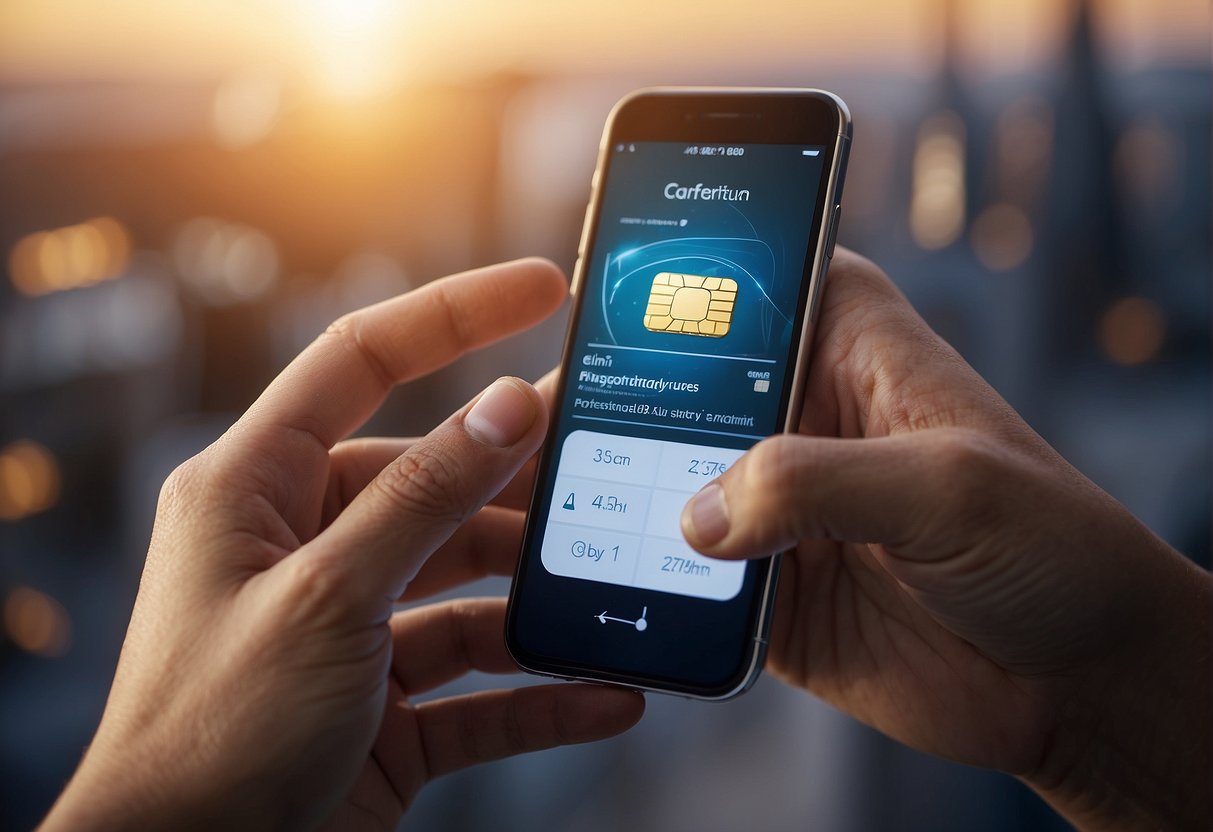Traveling internationally often involves navigating various mobile service providers and juggling different SIM cards to stay connected. But technological advancements have simplified this process with the introduction of embedded SIM (eSIM) technology. eSIMs offer a digital alternative to traditional physical SIM cards, allowing travelers to switch carriers without needing to physically replace the SIM card in their devices.

As smartphones like the iPhone and Samsung Galaxy grow ever more sophisticated, they increasingly include eSIM capabilities. International travelers can now enjoy seamless connectivity by purchasing and activating eSIM data plans specific to their destination countries, avoiding the high costs of roaming fees associated with their home providers. With eSIM technology, it’s possible to preload your phone with a local data plan or select a global plan that covers multiple regions, all before boarding your flight.
Key Takeaways
- eSIM technology allows for a more flexible and convenient way to manage mobile services during international travel.
- Activating an eSIM data plan can be more cost-effective compared to traditional roaming options.
- Many smartphones now support eSIM, making it easier for travelers to stay connected abroad.
Understanding eSIM Technology
eSIM technology marks a significant shift from traditional SIM cards by offering a digital alternative that enhances flexibility and security for international travelers.
What Is an eSIM?
An eSIM is an embedded SIM, a digital SIM card that is pre-installed in a mobile device. Unlike physical SIM cards, there is no need for a physical card; instead, activation occurs through software. Travelers can conveniently download data plans from various carriers onto a single eSIM by scanning a QR code, which securely stores the necessary information.
eSIM vs Physical SIM Cards
eSIMs and physical SIM cards serve the same purpose—to connect devices to a mobile network. However, eSIMs offer several advantages:
- No Physical Swapping: eSIMs eliminate the need for handling tiny physical cards, reducing the risk of loss or damage.
- Multiple Plans: They can hold multiple data plans, making it easier to switch between networks.
- Space-saving Design: eSIMs free up space inside devices that could be used for other features.
eSIM compatibility is an important consideration; not all devices support this technology yet. Those that do allow for a data-only eSIM or full mobile plans, giving users a range of options to stay connected while traveling.
Preparing Your Phone for International Travel
Before jetting off abroad, ensuring your phone’s readiness is essential for a seamless travel experience. This includes verifying compatibility with international networks and transitioning to an eSIM if your device supports it.
Ensuring Device Compatibility
To utilize your phone internationally, it must be unlocked and compatible with the networks of your destination. Major smartphone manufacturers such as Apple, Samsung, and Google Pixel offer devices that typically support global GSM frequencies. Most recent models, like the iPhone XS and later, certain Samsung Galaxy phones, and Google Pixel models, already accommodate eSIM technology alongside traditional SIM cards.
iOS and Android users should check their specific phone model’s specifications for international roaming capabilities. For iPhone users, this can mean ensuring the device supports an eSIM, as newer models do. Android users should verify with their device manufacturer or carrier for international usage options.
Switching from Physical SIM to eSIM
Shifting from a physical SIM card to an eSIM (embedded SIM) can be a convenient way to manage your phone services while traveling. Here is a step-by-step process for esim activation:
- Backup your phone: Ensure all contacts, messages, and important data are safe.
- Contact your carrier: Inform them about your travel plans and request eSIM activation. Some providers may guide you through the process of temporarily deactivating your physical SIM card.
- Activation: Follow the carrier’s instructions to activate the eSIM on your phone. This may involve scanning a QR code or manually entering information.
By using an eSIM while traveling internationally, you might be able to enjoy local rates and avoid excessive roaming charges. Ensure that your device supports eSIM technology and that you have an internet connection to complete the setup abroad. Remember that while eSIMs are convenient, the availability and process may vary by the carrier and country.
eSIM Data Plans for International Travelers
For international travelers, eSIM data plans offer unparalleled convenience and flexibility, letting you switch plans without the need to physically swap SIM cards.
Choosing the Right Data Plan
When preparing for a trip that spans multiple countries, one should carefully evaluate the data plans available. Regional plans offer coverage across several neighboring countries, preventing the need to purchase separate plans for each destination. Travelers should consider the duration of their trip as well as their data usage habits to select an adequate data package. A few days of travel may only require a modest amount of mobile data, whereas a multi-week itinerary might benefit from an unlimited data plan.
Benefits of eSIM for Frequent Travelers
The benefits of an eSIM for frequent travelers are significant. The ability to store multiple data plans on a single eSIM makes it ideal for those regularly hopping between countries. This eliminates the hassle of managing different physical SIM cards for each country. What’s more, an eSIM can usually be set up before departure, ensuring that travelers have access to mobile data upon arrival. Security is another advantage, as eSIMs cannot be physically removed, providing an extra layer of protection against loss or theft.
eSIM Providers and Coverage
Choosing the right eSIM provider is crucial for seamless connectivity during international travel. This section draws a comparison between various service providers, with a focus on network coverage and speed, critical for staying connected abroad.
Comparing eSIM Providers
When traveler’s compare eSIM providers, key factors include the number of countries covered, cost of services, and ease of use. For instance, Nomad offers budget-friendly options for travelers, covering more countries. In contrast, Airalo positions itself as an overall excellent eSIM provider, due to its comprehensive range of plans. BNESIM caters to travelers with their offers on unlimited data packages and international phone numbers, providing coverage in over 170 countries. Further, providers like Holafly and SIM2Fly are also in the competition, catering to international travelers with various data packages.
- Nomad: Cost-effective, extensive coverage
- Airalo: Variety of plans, favored by many
- BNESIM: Unlimited data, numerous countries
- Holafly: User-friendly, easy setup
- SIM2Fly: Popular in Asia, competitive rates
Each provider offers different packages and services, so it’s recommended for individuals to assess their travel needs before choosing a global eSIM provider.
Understanding Network Coverage and Speed
Coverage area and internet speed can greatly vary between eSIM providers. It’s imperative for travelers to ensure that their chosen provider offers extensive coverage in their destination countries. Speed is another vital aspect, especially for those relying on high-speed data for navigation, streaming, or work-related tasks.
Providers such as Airalo and BNESIM boast wide-reaching coverage, spanning across a significant number of countries. Their service speed is generally reliant on local network partnerships and can impact the user experience. Travelers should confirm that their service provider has agreements with local carriers in the destination to ensure optimum network coverage and speed.
To sum up, the choice of eSIM providers and the network coverage and speed they offer can make or break the international travel experience from a connectivity standpoint. It’s advisable for travelers to invest time in understanding their travel needs, and matching those with the right eSIM service provider.
Pricing and Subscription Options

When considering eSIMs for international travel, travelers are often concerned with finding cost-effective solutions and flexible subscription plans that can easily adapt to their itineraries.
Cost-Effective Travel with eSIMs
Travelers can enjoy affordable travel passes with eSIMs, which often come at a lower price point than traditional roaming charges. Providers such as Airalo offer a variety of local, regional, and global eSIM plans, which provide a more cost-efficient way to stay connected. For example, a traveler can purchase a prepaid data plan for Europe at a fraction of what traditional carriers charge for roaming services.
Subscription Plans and Flexibility
Providers typically offer a range of subscription plans to meet different travel needs. Flexibility is key, with options for both short-term and long-term travel available. Prepaid plans enable customers to pay upfront and know exactly what they’re getting, be it a limited amount of data or an unlimited data package. Some services, like Nomad, cater to budget-conscious travelers with competitively priced options. These plans can often be managed and adjusted via an app, providing a seamless experience for subscribers.
Customer Support and Services

When selecting an eSIM for international travel, the quality of customer support and the breadth of additional services offered are critical for a seamless experience. Travelers depend on efficient customer support for assistance during set-up or troubleshooting, and value-added services can greatly enhance their connectivity options.
Access to Customer Support
Travelers expect prompt and effective customer support from their eSIM service provider. For instance, a provider like Airalo boasts rapid response times to customer inquiries. eSIM users can typically seek help through various channels such as email, chat support, or dedicated phone lines. Some providers offer 24/7 support, ensuring that help is available regardless of the time zone one finds themselves in.
- Response Time: Providers like Airalo answer queries within minutes.
- Support Channels: Email, live chat, phone lines.
- Availability: Round-the-clock support to accommodate different time zones.
Additional Services Offered
Beyond customer support, eSIM providers may offer additional services that benefit international travelers. Such services can include on-the-go hotspot options for sharing connectivity with other devices, access to Wi-Fi in various international locations, or integrated VPN services for secure browsing.
- Hotspot Capability: Share a smartphone’s eSIM connection with other devices.
- Wi-Fi Access: Utilize available Wi-Fi networks to save on mobile network usage.
- Secure Browsing: A VPN service helps protect a traveler’s online activity on public networks.
Providers that support advanced features like these deliver a more robust and secure telecommunications experience, which can be essential for travelers relying on constant, secure connectivity while abroad.
How to Manage Multiple eSIMs
Managing multiple eSIMs while traveling can offer travelers seamless connectivity across different countries and regions. Practical organization of eSIM profiles and understanding the right plan for each destination are critical for a hassle-free experience.
Using eSIMs in Multiple Countries
Travelers can benefit from having multiple eSIMs activated when visiting multiple countries. Each eSIM allows access to local data plans, ensuring better coverage and often lower costs than traditional roaming services. One might have an eSIM for their home region and another for the destination country. For instance, travelers can use eSIM while traveling internationally with their iPhone, maintaining a number for home and a local number at the destination.
To optimize use across different regions, travelers should:
- Investigate whether their destination countries support eSIM technology.
- Acquire eSIMs that cater to regional or local plans to avoid high roaming rates.
- Confirm if their devices can store and switch between multiple eSIMs effortlessly.
eSIM Profiles and Management
Efficiently managing eSIM profiles is key to utilizing them during international travel. Most smartphones that support eSIM technology allow users to store several eSIMs simultaneously but typically activate only one or two at any given time.
When handling eSIM profiles, individuals should:
- Understand the process of adding, removing, or switching eSIM profiles within their device settings.
- Ascertain that they have different profiles for each area they plan to visit, giving them access to various local plans and an international phone number.
A traveler’s device acts as a hub for all their eSIM needs, enabling them to switch data plans according to their geographical location, thereby managing costs and staying connected efficiently.
Security and Privacy Considerations

When travelers opt for an eSIM while roaming internationally, they embrace a platform that enhances the security of their mobile data. Unlike traditional SIM cards, eSIMs are embedded into the device, rendering them non-removable and therefore less susceptible to theft or loss.
Data Security: eSIMs provide an additional layer of security because the profiles are downloaded and installed directly from the carrier, often protected by encryption. This minimizes the risks associated with physical SIM swaps and unauthorized access.
VPN Usage: Travelers should consider using a VPN to secure their internet connection when using eSIMs abroad. A VPN establishes a protected network connection, ensuring that data transmission is encrypted and secure, especially when using public Wi-Fi.
| Aspect | Consideration |
|---|---|
| Data Privacy | Utilize eSIM encryption and carrier-provided security features. |
| VPN | Always use a trusted VPN service to encrypt data while accessing the internet. |
| VOIP Calls/FaceTime | Enable end-to-end encryption for VOIP calls and FaceTime to protect communication. |
Privacy is paramount; hence travelers using their eSIM for internet access should ensure that their privacy settings are configured correctly on their devices. Strong passwords and biometric security features can also provide a robust defense against unauthorized device access.
For VOIP calls and FaceTime, it is advantageous to use services with end-to-end encryption. These services ensure that conversations remain private and are only accessible to the communicating parties.
In summary, while eSIMs offer a convenient and secure way to stay connected, travelers must remain vigilant about their digital security and privacy practices. They should use comprehensive security measures, such as VPNs and strong encryption, to guard against potential cybersecurity threats.
Technical Support and Troubleshooting

When travelers encounter issues with their eSIM while abroad, resolving them quickly is crucial. They may face challenges such as connectivity issues or inability to access mobile networks. It is important for them to be aware of the technical support options available.
Initial Troubleshooting Steps:
- Restart the device: This can resolve many minor network issues.
- Check for carrier settings update: Ensuring the latest settings can improve connectivity.
- Manage eSIM settings: Travelers should verify that their eSIM profile is activated in their device’s settings.
If issues persist, travelers should seek assistance through:
- Customer Support: Reaching out to their eSIM service provider should be the first step for technical issues. Service providers often offer a dedicated helpline or chat support.
- Online Resources: Many service provider websites have a troubleshooting section for self-service support.
For problematic internet access or hotspot functionality:
- Verify hotspot settings are configured correctly, as they vary by device and operating system.
- Check for any network restrictions that might be affecting usage, such as data caps or supported bands in the region.
Travelers can usually manage and troubleshoot their eSIM directly from their device, allowing them to access a local mobile network without incurring roaming fees. However, if technical issues are outside the realm of simple fixes, they should not hesitate to use the resources provided by their service provider for a resolution.
Frequently Asked Questions
In this section, readers will find precise answers to common queries regarding the use of eSIMs for international travel, helping to streamline their travel tech needs.
What are the top eSIM providers for frequent international travelers?
Providers like TechRadar and BNESIM are considered top choices for international travelers, offering extensive coverage and various plan options to suit different travel needs.
Are there any cost-effective eSIM options for worldwide travel?
Yes, some eSIM providers offer competitive plans, such as a 140-country plan starting at $19/GB, highlighting the potential savings for travelers as detailed by providers like TechRadar.
How do I set up an eSIM when traveling to multiple countries?
Travelers should begin by selecting a suitable eSIM service that covers all their destinations. Instructions on how to activate and manage eSIMs are concisely explained by resources like The New York Times guide.
What should I consider when choosing an eSIM for international roaming?
It’s essential to check device compatibility, coverage areas, plan flexibility, and pricing. The eSIM provider should offer options that align with one’s travel itinerary and budget.
Can I make international calls with an eSIM, and what are the rates?
One can make international calls using an eSIM; however, rates vary by provider. Some providers offer unlimited data packages and international phone numbers, as is the case with BNESIM.
What are the common issues faced with eSIMs during international travel and how can they be addressed?
Challenges may include compatibility issues or connection problems. A comprehensive guide for troubleshooting is provided by portals like ByteSIM, ensuring travelers can handle potential issues effectively.
Leave a Reply